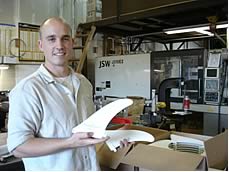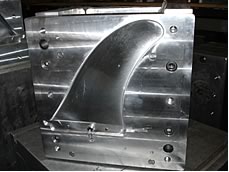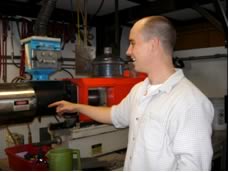Fluid Earth Fins: Henry Swales Interview
I was at my local surf shop recently talking about this and that, when the owner, knowing my penchant for green surf products, put a 9” longboard fin in my hand and informed me that it was a fully recyclable plant based fin manufactured right here in my hometown of San Luis Obispo, California. With my interest piqued, I contacted owner/operator Henry Swales and set up an interview.
 Phoresia: Tell me a little bit about your background and how you came to manufacturing surfboard fins.
Phoresia: Tell me a little bit about your background and how you came to manufacturing surfboard fins.
Henry: Well I attended Cal Poly State University in San Luis Obispo and majored in Aerospace Engineering. After graduation I moved to the Pacific Northwest to work for the Kite Boarding manufacturer North. Eventually I returned to San Luis Obispo and began working for a company that specializes in thermo plastic manufacturing, it was here that the idea for fluid earth was born.
P: Can you elaborate on that a little?
H: Sure. Working with injection molded thermo-plastics and knowing a little about plant based bio-plastics, I started thinking about ways to combine the two into eco-friendly surf products.
P: So Fluid Earth is just you?
H: Yep
P: And all your manufacturing is done right here in SLO?
H: Yep, it is all done right here by me.
 P: Let’s talk about your products. Right now you only offer a 9” Longboard fin. Any plans for other fin templates, fin systems, leash plugs, etc?
P: Let’s talk about your products. Right now you only offer a 9” Longboard fin. Any plans for other fin templates, fin systems, leash plugs, etc?
H: Yeah, all of it. I plan on coming out with a few sizes in center fins, as well as a few templates for shortboard fins. But right now my big thing is (center) fin boxes and leash plugs. It would be great to get some green options for those items to market so shapers using BioFoam and other alternative materials can offer a more complete green package.
P: Speaking of green, you talk about using plant based bio-plastics and your website touts your fins as being fully recyclable. Are your fins 100% plant based and is the recycling process also “green”?
H: Right now the fins use roughly 50% corn-based bio-plastic; the other 50% is composed of performance modifiers, all of which are non-toxic and biodegradable. I can see that percentage going toward 100% in the next five years however, as new technologies develop and come online. The recycling process is strictly mechanical and requires zero harsh chemicals or solvents.
P: Can you elaborate on the mechanical recycling process?
 H: Sure. Damaged fins are fed into a machine, which reduces the fin into small plastic pellets. These reclaimed pellets can then be combined with new materials and be recast into a new fin. Overall there is very little waste or loss involved.
H: Sure. Damaged fins are fed into a machine, which reduces the fin into small plastic pellets. These reclaimed pellets can then be combined with new materials and be recast into a new fin. Overall there is very little waste or loss involved.
P: Let’s talk about the fins themselves. Where did you look to for inspiration and how do they stack up against fiberglass fins for weight and flex?
H: Of course for inspiration I looked to the greats like Greenough, but also I spent a lot of time looking to the natural world, mostly dolphins, and fish.
Fluid Earth fins are generally lighter in weight than a standard fiberglass fin and have excellent flex patterns, in large part because the manufacturing process allows for a linear “grain” to the fin.
P: Where can people find Fluid Earth fins and accessorize?
H: Currently only a couple of surfshops in San Luis Obispo are carrying my fins, but hopefully that will change soon. So right now the best way for anyone interested is via my website at www.fluidearth.org.
P: Any parting thoughts or words of wisdom?
H: (Laughs) Oh, I don’t know, I guess just that I really enjoy helping to promote change within the surf industry, and am optimistic with the direction the industry is heading right now.
P: Thanks for your time Henry.
Author’s note: Fluid Earth is a carbon neutral company and is a member of 1% for the Planet. Additionally, to promote recycling Fluid Earth offers a 20% discount on a new fin purchase when you submit a damaged fin for recycling. For more info email at info@fluidearth.org
about the author:Daniel is the author of Wine and Woodsmoke. He is an ecologist by trade and lives and surfs on California’s Central Coast. We are stoked to have him contribute to Phoresia and look forward to posting more of his thoughts. As always we welcome your comments, suggestions and contributions.
“Right now the fins use roughly 50% corn-based bio-plastic; the other 50% is composed of performance modifiers, all of which are non-toxic and biodegradable.”
So how long does it take to biodegrade? Remember, plastic bags are biodegradable…in roughly 500 years.
Jeff-
I have left this as a comment on Phoresia in the past and offer it again here.
Please do not confuse degradation with biodegradation.
To clarify:
Biodegradability is the process by which a substance is broken down into its original organic components by living organisms (usually bacteria). Many (not all, but most) plastics cannot be broken down biologically and thus do not biodegrade, rather they are broken down mechanically or are photo-degraded (i.e. broken down by sunlight). Mechanical and photo degradation do not return plastics back to their original hydrocarbon or organic constituents (which by the way many hydrocarbons CAN be biodegraded via bacteria), rather they simply result in ever smaller pieces of plastic! One catastrophic result of this process it the alarming ratio of plastic to zooplankon in the north Pacific gyre (check out this disturbing video by Patagonia for a more on this: http://youtube.com/watch?v=Verhi88kR60).
Jeff,
Thanks for your interest and concern. There is some misinformation here. Not all of the components of this composite are biodegradeable. For example: the reinforcement fibers come from natural silica sand, but like sand or glass, they will never degrade past that natural state. These fins are not designed to be disposeable; thus all efforts have been made to make them recycleable should they be damaged, but not quickly degradeable.
Henry-
Thanks for the clarification!